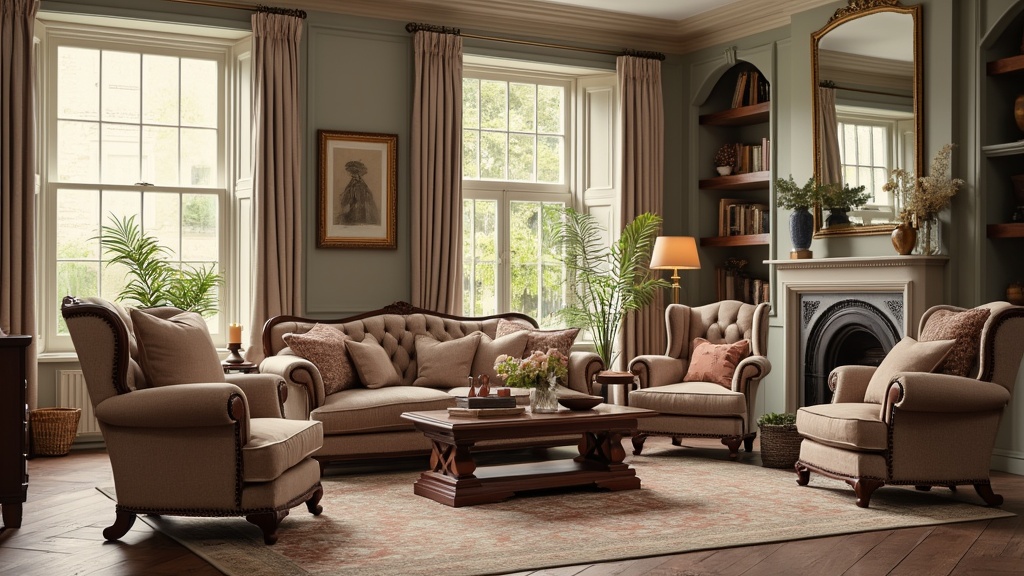Transform your living spaces with British-inspired furniture, known for its charm and sophistication. These timeless designs beautifully blend contemporary elements with vintage aesthetics, resulting in a unique atmosphere that enhances comfort and elegance.
British furniture design features classic UK styles that are both functional and artistic, offering a perfect balance for cozy settings and upscale spaces.
Intricate details and quality craftsmanship techniques elevate these pieces, making them essential statement furniture for modern households.
Embrace the richness of British-inspired designs to redefine your home’s interior decor.
Click here to learn more about: solid wood furniture
Delving into British Furniture Design
Exploring British furniture design reveals a fascinating tapestry of history and style. This field showcases influences from various historical periods, including the Tudor era and modern design trends.
The Georgian influence and the Arts and Crafts Movement have particularly shaped contemporary themes. Key characteristics of British furniture design include:
- Durable Materials: The use of quality oak and rich mahogany showcases a commitment to functionality and beauty.
- Craftsmanship Techniques: Exceptional craftsmanship fosters a resurgence in handcrafted quality, ensuring each piece upholds the craftsmanship legacy.
- Ornate Details: Intricate embellishments exemplify the traditional decor that defines British styles.
To identify authentic pieces, examine joinery and seek maker’s marks for insights into the furniture’s true origins. This attention to detail reflects the enduring appeal of bespoke furniture, exemplifying timeless elegance for stylish storage solutions and beyond.
Key Influences in British Furniture Design
Various historic motifs contribute to the evolution of British furniture styles. While the Victorian aesthetics emphasized intricate craftsmanship, more minimalist aesthetics gained prominence in recent decades. This tapestry of influences allows for versatility, accommodating both rustic interiors and modern urban styles.
The Role of Craftsmanship
The significance of craftsmanship cannot be overstated in British furniture design. Emerging designers focus on maintaining high craftsmanship standards, in addition to integrating ecofriendly materials. Such innovations ensure a commitment to sustainability while celebrating historic techniques. Nearly all pieces reveal a dedication to quality that encourages ethical production.
Practical Tip for Identifying Authentic Pieces
When searching for authentic furniture, keep these practical tips in mind:.
- Inspect joinery: Well-crafted pieces showcase tight and even joins.
- Look for maker’s marks: Reputable makers often stamp their designs, providing a traceable provenance.
- Consider material quality: Authentic pieces typically feature premium materials such as luxurious leather and exquisite wood.
By applying these tips, you can successfully navigate the world of British furniture design and discover pieces that reflect both heritage influences and modern functionality.

What Are Classic UK Styles
Classic UK styles represent a rich tapestry of distinctive elements that shape British interior design through the centuries. These styles are deeply connected to significant historical events and cultural movements, including Georgian, Victorian, Edwardian, and Art Deco.
For instance, the Georgian style, prevalent from 1714 to 1830, is known for its emphasis on symmetry and classical architecture.
In contrast, the Victorian aesthetic, which thrived from 1837 to 1901, is defined by rich fabrics and ornate details that reflect the opulence of the era.
Edwardian styles tend to favor light colors and floral patterns, adding a sense of freshness to the interior landscape. Incorporating these classic UK styles into modern decor can be effortlessly achieved by blending traditional elements with contemporary accessories.
A practical tip is to mix vintage furniture pieces with modern designs to create a balanced aesthetic that honors the past while embracing the present.
Exploring Victorian Aesthetics In Furniture
The profound impact of the Industrial Revolution reshaped furniture design by making ornate Victorian aesthetics more accessible to the public. This transformative era saw the increased use of rich mahogany and intricate upholstery materials that highlighted artisans’ skills.
Ornate craftsmanship became a defining characteristic of Victorian furniture, showcasing detailed workmanship that speaks to the era’s craftsmanship standards.
To discover authentic Victorian pieces, one might explore estate sales, specialized antique shops, and online auctions, offering a treasure trove for furniture enthusiasts.
Blending Victorian elements with contemporary decor is achievable through the use of statement pieces, such as a chesterfield sofa, which can serve as a focal point in minimalist settings, ensuring they enhance rather than overwhelm the overall space.
Classic UK Styles and Victorian Aesthetics
- Georgian style emphasizes symmetry and classical architecture, reflecting the period’s values.
- Victorian furniture is characterized by rich fabrics and ornate details, showcasing the craftsmanship of the era.
- Edwardian styles introduce light colors and floral patterns, adding freshness to interiors.
- Mixing vintage pieces, like a chesterfield sofa, with modern decor can create a balanced aesthetic.
The Georgian Influence On Modern Design
Georgian design principles significantly impact modern aesthetics, shaping how contemporary interiors are conceived. Symmetry and proportion remain foundational aspects that resonate with today’s architectural layouts, ensuring harmonious spaces.
Notably, intricate detailing, once a hallmark of Georgian furniture, continues to inspire luxury designs today.
To effectively incorporate Georgian elements, consider using bold, patterned textiles reminiscent of the era and accessorizing with intricately framed mirrors to reflect light and enhance grandeur.
Iconic figures such as Thomas Chippendale and George Hepplewhite exemplify the lasting influences in furniture design, melding artistry and functionality that remain relevant in upscale environments.
Key Georgian Design Principles
Classic UK styles are evident in the emphasis on harmony and balance. Furniture pieces, such as wingback chairs and chesterfield sofas, often showcase elegant lines and rich materials.
Georgian influence extends to modern design through quality oak, rich mahogany, and luxurious leather, which are integral to current furniture trends. Integrating these elements can create a timeless appeal in urban or rustic interiors.
Modern Trends Inspired by Georgian Aesthetics
Contemporary appeal is often derived from Georgian design, where craftsmanship standards prioritize comfort, elegance, and functionality.
Current trends feature statement furniture that pays homage to historic motifs while embracing minimalist aesthetics.
Emphasizing traditional decor alongside modern design allows for eclectic themes that enhance cozy settings and upscale spaces.
Craftsmanship Techniques Behind Timeless Pieces
Exploring craftsmanship reveals essential qualities that define superb furniture.
Traditional techniques such as dovetail joints continue to serve as a benchmark for sturdy construction in modern design. Hand-carving, a skill celebrated for its creativity, contributes unique character to bespoke furniture.
High-quality craftsmanship influences both durability and aesthetics; methods like veneering offer beauty and resilience, ensuring furniture can last generations.
Evaluating Craftsmanship in Modern Furniture
To assess craftsmanship in contemporary pieces, look for visual signs of skilled workmanship, such as joint precision and finish quality. Evaluating these aspects can provide insights into the craftsmanship legacy and its relevance to current styles.
Resources like books on historical techniques and hands-on workshops can enrich knowledge, connecting the dots between heritage influences and evolving furniture standards.
Learning More About Craftsmanship Techniques
- Consider enrolling in workshops focused on traditional furniture making.
- Explore literature that details craftsmanship techniques and their historical context.
- Visit museums or exhibitions showcasing pieces from various eras to understand the evolution of design.
Georgian Influence on Modern Design
- Georgian design is characterized by symmetry and proportion, which are key elements in contemporary architecture.
- Iconic furniture designers like Thomas Chippendale and George Hepplewhite have set standards that are still admired in today’s luxury markets.
- Modern furniture trends often incorporate high-quality materials such as oak, mahogany, and leather, reflecting Georgian craftsmanship.
- Traditional techniques like dovetail joints and hand-carving are essential for creating durable and aesthetically pleasing furniture.
How To Choose Sustainable Furniture Styles
Selecting sustainable furniture styles involves a careful assessment of available materials and design practices. Begin by researching ecofriendly materials such as bamboo, reclaimed wood, and organic fabrics, which significantly contribute to a reduced environmental footprint.
Ethical sourcing remains essential; brands adhering to certifications like the Forest Stewardship Council are more likely to ensure their products meet sustainability standards.
Seek out durable pieces that embody timeless designs, aligning seamlessly with your eco-conscious values.
Notably, investing in brands recognized for their commitment to sustainable practices, such as West Elm and IKEA, can be beneficial. Unique fact: selecting quality oak furniture promotes waste reduction and enhances long-lasting use significantly.
Embracing Rustic Interiors With Elegance
Rustic charm combined with modern elegance offers a unique design aesthetic that appeals to many homeowners.
Key elements of this style include reclaimed wood, wrought iron, and stone, which not only enhance authenticity but also evoke a sense of rural charm. Incorporating decorative accents, such as luxurious leather wingback chairs and vintage farmhouse tables, enhances the cozy atmosphere found in such settings.
To achieve this aesthetic effectively, consider practical tips like using layered lighting to foster an inviting ambiance.
Unique insight: Mixing different textures and finishes can deepen visual appeal, ensuring a dynamic yet harmonious space while resonating with classic design influences.
Key Elements of Rustic Yet Refined Spaces
Essential components of rustic interiors include quality oak and rich mahogany elements, which contribute to a timeless appeal.
Incorporating handcrafted quality alongside ornate craftsmanship in your selections can elevate the overall design. Utilize stylish storage solutions and versatile pieces to maintain functionality without sacrificing aesthetics.
This balance creates a seamless flow between comfort and elegance.
Practical Tips for Achieving the Aesthetic
When designing your rustic interior, focus on the importance of materials and textures to enhance the overall look. Experimenting with a combination of textiles can lead to innovative concepts that define your space.
Utilizing statement furniture pieces, like chesterfield sofas, can anchor the room while maintaining an upscale ambiance.
Sourcing local ecofriendly materials supports ethical production practices and reinforces the refined rustic style.
Sustainable Furniture and Rustic Interiors
- Bamboo and reclaimed wood are among the most sustainable materials, as they require less energy to produce and can be sourced responsibly.
- Furniture certified by the Forest Stewardship Council ensures that the wood used is harvested sustainably, promoting forest conservation.
- Using layered lighting in rustic interiors not only enhances the aesthetic but also improves the functionality of the space.
- Incorporating local ecofriendly materials can reduce transportation emissions and support community artisans, aligning with sustainable practices.
Why Are Wingback Chairs Iconic In Design
Wingback chairs represent a captivating integration of history, functionality, and aesthetic charm that continues to attract designers and homeowners. Originating from British furniture design during the 17th century, these chairs were originally crafted to offer warmth and comfort in drafty homes.
Their evolution demonstrates how tastes have shifted, seamlessly transitioning through iconic styles like Victorian aesthetics and contemporary interpretations.
The Historical Significance of Wingback Chairs
These historic pieces not only provide exceptional support—benefiting relaxation and reading—but also function as statement furniture in a variety of interiors.
Their design evolution showcases a blend of craftsmanship techniques, revealing influences from Georgian furniture styles that emphasized both comfort and elegance.
Today, wingback chairs maintain their role as timeless appeals in both urban style and rustic interiors.
Selecting the Right Wingback Chair
Selecting the right wingback chair involves thoughtful consideration of size, material, and style to complement your space’s overall decor. Look for quality oak or rich mahogany finishes that can elevate the chair’s presence in any environment.
Whether opting for luxurious leather or ecofriendly materials, the right choice can enhance both functionality and visual impact.
Styling Wingback Chairs in Modern Interiors
Styling wingback chairs effectively can transform your home furnishings into sophisticated focal points. Consider pairing them with chesterfield sofas and farmhouse tables to create a cohesive look that balances tradition with modern design.
Incorporating intricate details and ornate craftsmanship will enrich the design narrative of your interiors, making them striking yet inviting.
Wingback Chairs
- Wingback chairs originated in 17th century Britain to provide warmth in drafty homes.
- They serve as both functional seating and statement pieces in various interior styles.
- Quality materials like oak and mahogany enhance the visual appeal and durability of wingback chairs.
- Pairing wingback chairs with chesterfield sofas and farmhouse tables creates a harmonious blend of traditional and modern design.



